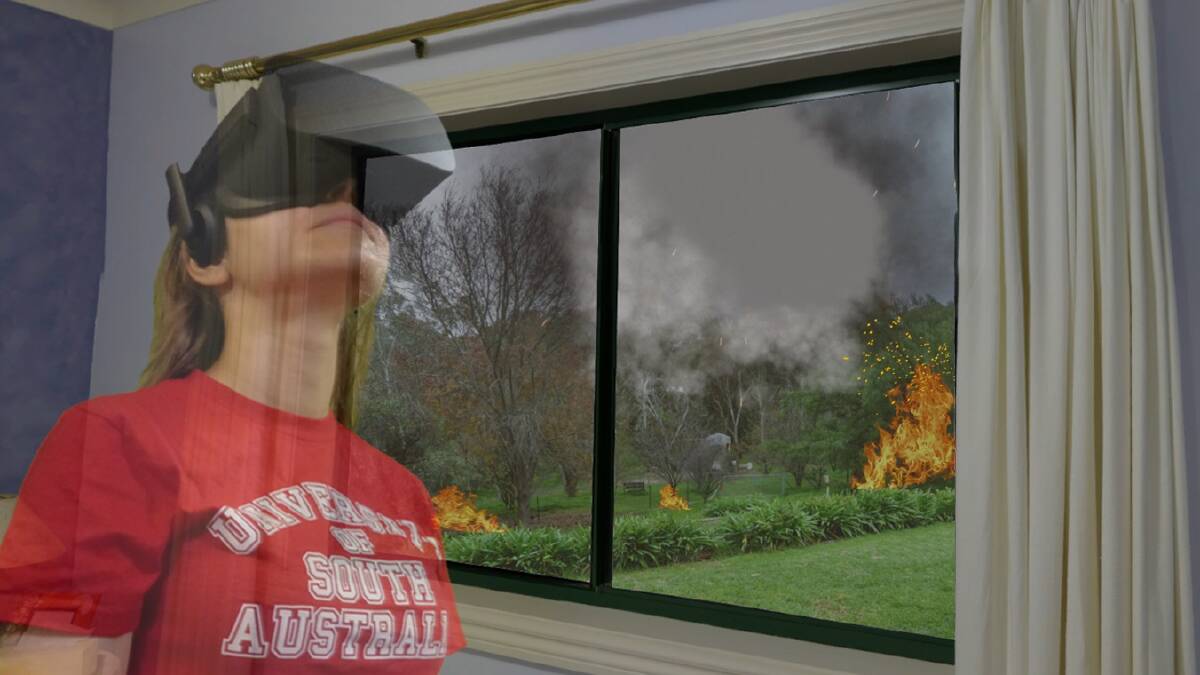
A virtual reality exercise undertaken with people living in high fire-risk zones has revealed many people are "woefully underprepared" to deal with a serious fire, and many would make potentially fatal errors if a fire was to strike.
Allowing people to "safely" experience a raging bushfire, by replicating a computer-generated bushfire using virtual reality, University of SA researchers studied the responses of 400 people living across Greater Adelaide, the Mount Lofty region and the Riverland, in an Australian-first experiment.
Particpiants experiences 17 bushfire scenes through the 3D headset, including early warning signs, changeable weather conditions, the sights and sounds of the fire movement through a property and threatening lives, and after the fire front had passed.
Two versions of the virtual reality scenario were prepared - one for residents who planned to 'stay and defend' and a second for those intending to 'wait and see'. The latter group were virtually prevented from leaving their property by a tree blocking their access route, reinforcing the need for a contingency plan.
Prior to the exercise, 55 per cent of participants said they would 'wait and see' on a severe fire day rather than committing to evacuate early or 'stay and defend', while 68pc incorrectly believed the bathroom was the safest place to shelter.
After the exercise, which immersed respondents in every element of a fire crisis apart from heat, many of the non-committal group changed their minds, saying they were more likely to evacuate early after virtually experiencing bushfire conditions.
We need fundamentally different approaches to educate people about bushfire plans, and virtual reality is a very effective one.
- DELENE WEBER
Three months following the exercise, 75pc of respondents remembered the advice to shelter in a room with multiple exits as far away as possible from the fire front. The same percentage said the exercise had 'greatly informed' their knowledge of bushfire and bushfire preparation, and the need for a survival plan.
Prior to the exercise, 25 pc of the 'wait and see' group had a written survival plan, compared to 52pc of the 'stay and defend'.
Receiving the CFS 'watch and act' message acted as a first trigger for 37 pc of the 'wait and see' cohort to leave and another 20 per cent in that group elected to leave once their neighbours evacuated.
Just 14pc of that group decided they would stay and fight the fire after experiencing it virtually.
The study also showed participants in the 'stay and defend' cohort were more consistent and less erratic in their responses.
RELATED READING: Black Hawks elevate SA's bushfire defence
UniSA Professor of Environmental Science, Delene Weber, who oversaw the study with PhD candidate Safa Molan, said the results pointed to how virtual reality could be a valuable training and educational tool for people living in high-risk fire zones.
"Many of these people have never experienced a life-threatening bushfire before and have no understanding of how they would react or what decisions they would make under extreme pressure," Ms Weber said.
"But lack of preparation is not a new phenomenon. Records of the number of bushfire fatalities in the past 200 years show that almost a third of deaths have occurred because of late evacuation and poor decisions."
Ms Weber said the study showed many participants were not ready to deal with a fire, in either a practical or emotional sense.
"What was clear from this virtual reality scenario is that we need fundamentally different approaches to educate people about bushfire plans, and virtual reality is a very effective one.
"The beauty of virtual reality is that we can adapt and customise scenarios to target different groups of people, including women and those who are more vulnerable."
The findings were published in the International Journal of Disaster Risk Reduction.
Start the day with all the big news in agriculture. Sign up here to receive our daily Stock Journal newsletter.

